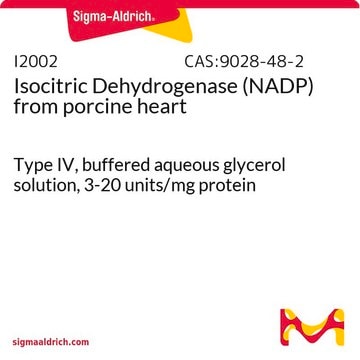I2516
Isocitric Dehydrogenase (NADP) from porcine heart
lyophilized powder, 20-60 units/mg protein (biuret)
Synonym(s):
threo-Ds-Isocitrate: NADP+ oxidoreductase, ICDH, IDH
About This Item
Recommended Products
form
lyophilized powder
specific activity
20-60 units/mg protein (biuret)
composition
Protein, ~20%
storage temp.
−20°C
Looking for similar products? Visit Product Comparison Guide
Quality
Essentially free of aconitase activity.
Unit Definition
Physical form
comparable product
inhibitor
Signal Word
Danger
Hazard Statements
Precautionary Statements
Hazard Classifications
Resp. Sens. 1
Storage Class Code
11 - Combustible Solids
WGK
WGK 3
Flash Point(F)
Not applicable
Flash Point(C)
Not applicable
Personal Protective Equipment
Choose from one of the most recent versions:
Already Own This Product?
Find documentation for the products that you have recently purchased in the Document Library.
Our team of scientists has experience in all areas of research including Life Science, Material Science, Chemical Synthesis, Chromatography, Analytical and many others.
Contact Technical Service









